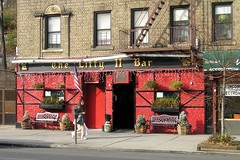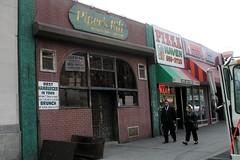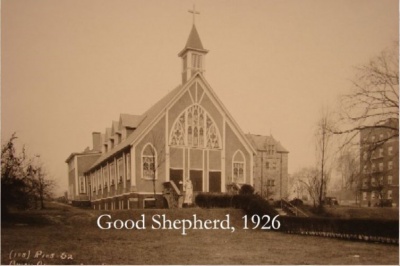Inwood
From The Peopling of New York City: Irish Communities
|
Neighborhoods: Woodlawn | Inwood | Hell's Kitchen | Woodhaven |
Built Environment/Economy
What is Inwood?
The neighborhood of Inwood in Manhattan still has traces of a strong Irish presence of the past. Natives of Ireland linger in the pubs, congregate on street corners, and even come together to watch the occasional Gaelic football matches that happen in Isham Park. The area itself is full of apartment buildings and there are almost no small edifices. Located within Inwood Inwood Park, this large park is known for having the last remnants of the original topography and terrain of Manhattan, including the last remaining marshes on the island. Also, Inwood is notoriously hilly and the park is full of large mountainous areas that are popular among hikers.
This video was created by the production company TurnHere, and is a narrated exploration of Inwood and Inwood park in the wintertime. Note the presence of Irish pubs and businesses.
Boundaries
Inwood is the northernmost neighborhood on Manhattan and it is surrounded by the Harlem River to the north and east, the Hudson River to the west, and depending on where one gets the information, the southern boundary is either Dyckman St. or Fairview Avenue. The Fort George neighborhood is to the south.
Irish History in Inwood
Though for the most part of the first part of the 1900s, the people who populated Inwood were of Irish and Jewish descent, there is a strong Latino presence, mostly Dominican, now. What once was a pub is now a bodega or a small Hispanic family owned establishment. If one would have asked a resident about the demographics of Inwood only twenty of thirty years ago, the person would have responded that it is one of the most recognizable Irish enclaves in the city. The number of Irish residents in Inwood has significantly dropped since then.
Presence of Irish Pubs
There were many Irish pubs on the streets of Inwood. Now there are only a couple of pubs scattered around Broadway. A couple of the few pubs that are left are: “Irish Eyes” on the corner of West 213th street and Broadway, the “Liffy II Bar” a block uptown from “Irish Eyes", and “The Piper’s Kilt”, which is found on the corner of 207th street and Broadway. They still serve pub food like Irish nachos (French fries with cheese and bacon) and a fish lunch special Fridays. And, of course, many Irish beers including Guinness, Double Diamond Ale, and Harp Lager.
Roman Catholic Presence
Religion is a major part of Irish culture and most of the Irish immigrants to New York City were Roman Catholic and this is evident in Inwood. Inwood has obviously changed a great deal from when it was almost exclusively an Irish neighborhood but the Church of the Good Shepherd is a reminder of the Old Inwood. This church is an excellent example of the Catholic presence and was a cultural center for the community. Now, it is a church that serves the overwhelming Latino population, with services in Spanish and shows how such a fixture in one culture can change and evolve with a community.
No Longer a Major Irish Neighborhood
Why did things change for Inwood? For one thing, it wasn't that the Irish suddenly decided to move away over night. There was actually a large influx of Irish immigrants to the United States from the late 1960s to the 1980s because of a large political conflict in Ireland called “The Troubles.” This conflict involved a lot of violence (over the period of three decades there were 3600 deaths). However, the Irish were no longer moving to Irish enclaves like Inwood anymore. Irish immigrants who had lived in Inwood from the 1950s were moving out; longtime Irish residents relocated themselves and their families to the suburbs. Inwood was becoming smaller and less secure as crime rates started to increase with the advent of the George Washington Bridge, which increased drug activity in the area.
But mostly, new immigrant groups were replacing them, primarily Latino immigrants from the Dominican Republic. Where once there were almost thirty Irish families living in apartment buildings is now a vacant space taken up by the Dominicans. The Irish do not feel as if they are being pushed out because it was their choice to move out and one can just get the sense that the dominant Irish culture of the area has run its course, and the remaining older Irish residents know this to be true.





